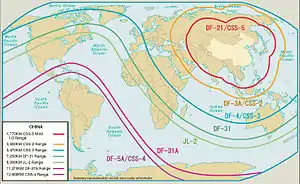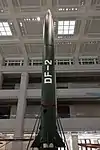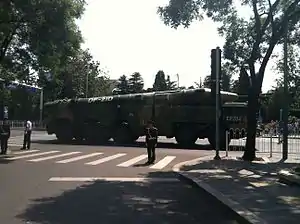
The Dongfeng (simplified Chinese: 东风; traditional Chinese: 東風; lit. 'East Wind') series, typically abbreviated as "DF missiles", are a family of short, medium, intermediate-range and intercontinental ballistic missiles operated by the Chinese People's Liberation Army Rocket Force (formerly the Second Artillery Corps).
History
After the signing of the Sino-Soviet Treaty of Friendship, Alliance and Mutual Assistance in 1950, the Soviet Union assisted China's military R&D with training, technical documentation, manufacturing equipment and licensed production of Soviet weapons. In the area of ballistic missiles, the Soviets transferred R-1 (SS-1), R-2 (SS-2) and R-11F technology to China.[1] The first Chinese ballistic missiles were based on Soviet designs. Since then, China has made many advances in its ballistic missile and rocket technology. For instance, the space launch Long March rockets have their roots in the Dongfeng missiles.
Dongfeng missiles

Dongfeng 1 (SS-2)
The first of the Dongfeng missiles, the DF-1 (SS-2, codenamed '1059', initially 'DF-1' , later the DF-3[1]), was a licensed copy of the Soviet R-2 (SS-2 Sibling) short-range ballistic missile (SRBM),[2] based on the German V-2 rocket. The DF-1 had a single RD-101 rocket engine, and used alcohol for fuel with liquid oxygen (LOX) as an oxidizer. The missile had maximum range of 550 km and a 500 kg payload. Limited numbers of DF-1 were produced in the 1960s, and have since been retired.[1]
Dongfeng 2 (CSS-1)

The DF-2 (CSS-1) is China's first medium-range ballistic missile (MRBM), with a 1,250 km range and a 15-20 kt nuclear warhead. It received the western designation of CSS-1 (stands for "China Surface-to-Surface").[3] It was long noted by western observers that the DF-2 could be a copy of the Soviet R-5 Pobeda (SS-3 Shyster), as they have identical look, range, engine and payload. The entire documentation for R-5 had been delivered from Soviet Union to China in the late 1950s.[4] But some western authors still attribute the design to Chinese specialists Xie Guangxuan, Liang Sili, Liu Chuanru, Liu Yuan, Lin Shuang, and Ren Xinmin. The first DF-2 failed in its launch test in 1962, leading to the improved DF-2A. The DF-2A was used to carry out China's test of a live warhead on a rocket on 27 October 1966 (detonated in the atmosphere above Lop Nor), and was in operational service since late 1960s. All DF-2 were retired from active duty in the 1980s.[5]
Dongfeng 3 (CSS-2)
The DF-3 (CSS-2) is often considered China's first "domestic" intermediate-range ballistic missile (IRBM). The common ICBM design was greatly influenced by the Soviet R-14 Chusovaya missile and the first stage engine itself was a direct copy of the С.2.1100/С.2.1150 La-350 booster engine developed by Aleksei Isaev at OKB-2 (NII-88). Design leadership has been attributed to both Tu Shou'e and Sun Jiadong. The missile was produced at Factory 211 (Capital Astronautics Co., [首都航天机械公司], also known as Capital Machine Shop, [首都机械厂]). The 2,500 km DF-3 was originally designed with a 2,000 kg payload to carry an atomic (later thermonuclear) warhead. A further improved DF-3A with 3,000 km range (~4,000 km with reduced payload) was developed in 1981, and exported to Saudi Arabia with a conventional high-explosive warhead.[6] The DF-3's range of 2,810 km means it is just short of being able to target Guam, although the 2012 DOD report on China's military power states that they have a range of 3,300 km, which would be enough to target Guam.[7] The 2013 Pentagon report on China's military power confirms the DF-3's 3,300 km range, and its maps show Guam being within the DF-3's range.[8] All DF-3/DF-3A's were retired by the mid-2010s and replaced by the DF-21.[9]
Dongfeng 4 (CSS-3)
The DF-4 (CSS-3) "Chingyu" is China's first two-stage ballistic missile, with 5,550-7,000 km range and 2,200 kg payload (3 Mt nuclear warhead). It was developed in late 1960s to provide strike capability against Moscow and Guam. The DF-4 missile also served as basis for China's first space launch vehicle, Chang Zheng 1 (Long March 1). Approx. 20 DF-4's remain in service, and are scheduled to be replaced by DF-31 by 2010–2015.[10][11]
Dongfeng 5 (CSS-4)

The DF-5 (CSS-4) is an intercontinental ballistic missile (ICBM), designed to carry a 3 megaton (Mt) nuclear warhead to distance up to 12,000 km. The DF-5 is a silo-based, two-stage missile, and its rocket served as the basis for the space-launch vehicle Fengbao-Tempest (FB-1) used to launch satellites. The missile was developed in the 1960s, but did not enter service until 1981. An improved variant, the DF-5A, was produced in the mid 1990s with improved range (>13,000 km). Currently, an estimated 24-36 DF-5A's are in service as China's primary ICBM force. If the DF-5A is launched from the eastern part of the Qinghai province, it can reach cities like Los Angeles, Sacramento and San Francisco. If it is launched from the most eastern parts of northeastern provinces, it can cover all of the mainland of the United States.
Dongfeng 11 (CSS-7)

The DF-11 (CSS-7, also M-11 for export), is a road-mobile SRBM designed by Wang Zhenhua at the Sanjiang Missile Corporation (also known as the 066 Base) in the late 1970s. Unlike previous Chinese ballistic missiles, the DF-11 use solid fuel, which greatly reduces launch preparation time to around 15–30 minutes, while liquid-fuelled missiles such as the DF-5 require up to 2 hours of pre-launch preparation. The DF-11 has a range of 300 km and an 800 kg payload. An improved DF-11A version has increased range of >825 km.[12] The range of the M-11 does not violate the limits set by the Missile Technology Control Regime (MTCR). Estimates on the number of DF-11s in service vary between 500 and 600.[13][14]
Dongfeng 12 (CSS-X-15)
The DF-12 (CSS-X-15) is an SRBM formerly known as the M20. The change in designation signalled a shift in fielding to the Second Artillery Corps, making it possible the missile could be armed with a tactical nuclear warhead. Images of it bear a resemblance to the Russian 9K720 Iskander missile which, although not purchased by China from Russia, could have been acquired from former Soviet states. Like the Iskander, the DF-12 reportedly has built-in countermeasures including terminal maneuverability to survive against missile defense systems. Range is officially between 100–280 km (62–174 mi),[15] but given MTCR restrictions, actual maximum range may be up to 400–420 km (250–260 mi). With guidance provided by inertial navigation and Beidou, accuracy is 30 meters CEP; since the missile is controlled throughout the entire flight path, it can be re-targeted mid-flight. The DF-12 is 7.815 m (25.64 ft) long, 0.75 m (2.5 ft) in diameter, has a take-off weight of 4,010 kg (8,840 lb), and an 880 lb (400 kg) warhead that can deliver cluster, high explosive fragmentation, penetration, or high-explosive incendiary payloads. They are fired from an 8×8 transporter erector launcher (TEL) that holds two missiles.[16][17][18][19]
An anti-ship ballistic missile export variant of the M20, called A/MGG-20B (M20B), was unveiled at the 2018 Zhuhai Airshow.[20]
Dongfeng 15 (CSS-6)

The DF-15 (CSS-6, also M-9 for export) was developed by the China Aerospace Science and Technology Corporation (CASC, previously known as the 5th Aerospace Academy)'s Academy of Rocket Motor Technology (ARMT, also known as the 4th Academy). The missile is a single-stage, solid-fuel SRBM with a 600 km range and a 500 kg payload. During the 1995-1996 Taiwan strait crisis, the PLA launched six DF-15's near Taiwan in a demonstration of the missile's capability. Although the DF-15 is marketed for export, its range would violate the Missile Technology Control Regime (MTCR) agreement, and thus no DF-15 has been exported to date. Approximately 300-350 DF-15's are in service with the PLA Rocket Force.[21][22]
Dongfeng 16 (CSS-11)

The DF-16 (CSS-11)[23] is a new-model missile that has a longer range than the DF-15 (between 800–1,000 km (500–620 mi)). A Taiwan official announced on 16 March 2011 that Taiwan believed China had begun deploying the missiles.[24] The DF-16 represents an increased threat to Taiwan because it is more difficult to intercept for anti-ballistic missiles systems such as the MIM-104 Patriot PAC-3. Due to its increased range, the missile has to climb to higher altitudes before descending, giving more time for gravity to accelerate it on re-entry, faster than a PAC-3 could effectively engage it.[25] The DF-16 is an MRBM longer and wider than previous models with a 1,000–1,500 kg (2,200–3,300 lb) warhead and 5-10 meter accuracy. Its bi-conic warhead structure leaves room for potential growth to include specialized terminally guided and deep penetrating warheads. It is launched from a 10×10 wheeled TEL similar to that of the DF-21, but instead of a "cold launch" missile storage tube it uses a new protective "shell" to cover the missile.[26][27] Nuclear capable.[28]
The missile was shown to the public during the 2015 China Victory Day Parade in Beijing celebrating 70-year anniversary of the end of World War II.[29][30][31][32]
Dongfeng 17
The DF-17 is a type of ballistic missile specifically designed to carry a hypersonic glide vehicle, such as DF-ZF.[33][34][35] its estimated range is 1,800-2,000 km, and reached initial operational capability in 2019.[36] It will be capable of delivering both nuclear and conventional payloads, as well as a maneuverable reentry vehicle instead of an HGV.[37] The first test of the DF-17 ballistic missile took place on 1 November 2017.[38]
Dongfeng 21 (CSS-5)

The DF-21 (CSS-5) is a two-stage, solid-fuel MRBM developed by the 2nd Aerospace Academy (now China Changfeng Mechanics and Electronics Technology Academy) in late 1970s. It was the first solid-fuelled ballistic missile deployed by the Second Artillery Corp. The missile carries a single 500 kt nuclear warhead, with up to 2,500 km (1,600 mi) range. The DF-21 also served as the basis for the submarine-launched ballistic missile (SLBM) JL-1 (CSS-N-3),[39] used on the Xia-class SSBN. In 1996, an improved variant, the DF-21A, was introduced. As of 2010, 60-80 DF-21/DF-21A were estimated to be in service; this number may have increased since then.[40][41] Sources say Saudi Arabia bought a DF-21 in 2007.
The latest variant, the DF-21D, has a maximum range exceeding 1,450 kilometres (900 mi; 780 nmi) according to the U.S. National Air and Space Intelligence Center. It is hailed as the world's first anti-ship ballistic missile (ASBM) system, capable of targeting a moving carrier strike group from long-range, land-based mobile launchers. The DF-21D is thought to employ maneuverable reentry vehicles (MaRVs) with a terminal guidance system. It may have been tested in 2005–2006, and the launch of the Jianbing-5/YaoGan-1 and Jianbing-6/YaoGan-2 satellites offering targeting information from synthetic aperture radar (SAR) and visual imaging respectively.
Dongfeng 25
The DF-25 was a mobile-launch, two-stage, solid-fuel IRBM with a range of 3,200 kilometres (2,000 mi). Development was allegedly cancelled in 1996.[42] The U.S. Department of Defense in its 2013 report to Congress on China's military developments made no mention of the DF-25 as a missile in service.[43]
Dongfeng 26

The DF-26C is an IRBM with a range of at least 5,000 km (3,100 mi), far enough to reach U.S. naval bases in Guam. Few details are known, but it is believed to be solid-fuelled and road-mobile, allowing it to be stored in underground bunkers and fired at short notice, hence difficult to counter. It is possible that the DF-26C is a follow-up version of the DF-21. Possible warheads include conventional, nuclear or even maneuverable anti-ship and hypersonic glide warheads.[44][45]
Dongfeng 27
The DF-27 is a long-range ballistic missile that is in development as of 2021, with a range of 5,000 km to 8,000 km.[46] The average speed is Mach 8.6 and China tested the missile on 25th February 2023, with it flying 12 minutes over a distance of 2,100km (1,300 miles) according to leaked secret documents.[47]
Dongfeng 31 (CSS-10)

The DF-31 (CSS-10) is China's newest road-mobile, solid-fuel ICBM developed by the 4th Aerospace Academy (now ARMT). The DF-31 has range of 8,000+ km, and can carry a single 1,000 kt warhead, or up to three 20-150 kt MIRV warheads. An improved version, the DF-31A, has range of 11,000+ km, far enough to reach Los Angeles from Beijing. The DF-31 was developed to replace many of China's older ballistic missiles, and served as basis to the new JL-2 (CSS-NX-4/CSS-NX-5) SLBM. In 2009, approx. 30 DF-31/DF-31A are estimated to be in service; it is possible this number may have increased since then.[48][49] 12 were displayed at the 2009 military parade in Beijing commemorating the 60th anniversary of the PRC's founding.
The latest variant DF-31AG was displayed at the 2019 parade taking place in Beijing celebrating the 70th anniversary of PRC.[36]
Dongfeng 41 (CSS-20)
The DF-41 (CSS-20), capable of being armed with ten or twelve MIRV warheads, is China's newest addition to its nuclear arsenal. With an estimated range between 12,000 - 15,000 km, it is believed to surpass the range of the US's LGM-30 Minuteman ICBM to become the world's longest range missile.[50][51]
References
Citations
- 1 2 3 DF-1 Archived 2017-07-31 at the Wayback Machine. GlobalSecurity.org.
- ↑ R-2 / SS-2 SIBLING Archived 2021-03-23 at the Wayback Machine. GlobalSecurity.org
- ↑ DF-2 / CSS-1 Archived 2009-09-10 at the Wayback Machine GlobalSecurity.org
- ↑ R-5 / SS-3 SHYSTER Archived 2018-10-07 at the Wayback Machine. GlobalSecurity.org
- ↑ DongFeng 2 (CSS-1) Intermediate-Range Ballistic Missile Archived 2011-01-03 at the Wayback Machine Sinodefence.com
- ↑ Archived 25 February 2012 at the Wayback Machine
- ↑ "Annual Report to Congress: Military and Security Developments Involving the People's Republic of China 2012" (PDF). United States Department of Defense. May 2012. Archived from the original (PDF) on 20 September 2014. Retrieved 14 September 2014.
- ↑ "Annual Report to Congress: Military and Security Developments Involving the People's Republic of China 2013" (PDF). United States Department of Defense. May 2013. Archived from the original (PDF) on 13 January 2015. Retrieved 14 September 2014.
- ↑ DongFeng 3 (CSS-2) Intermediate-Range Ballistic Missile Archived 2013-08-14 at the Wayback Machine Sinodefence.com
- ↑ DF-4 (the "Chingyu" missile) Archived 2018-12-15 at the Wayback Machine. GlobalSecurity.org.
- ↑ DongFeng 4 (CSS-3) Intermediate-Range Ballistic Missile Archived 2012-11-03 at the Wayback Machine Sinodefence.com
- ↑ "DONG FENG - EAST WIND/JULANG - GREAT WAVE". softwar.net. 2007. Archived from the original on 1 October 2014. Retrieved 14 September 2014.
- ↑ DF-11 (CSS-7) Archived 2022-02-27 at the Wayback Machine. GlobalSecurity.org.
- ↑ DongFeng 11 (CSS-7) Short-Range Ballistic Missile Archived 2012-06-06 at the Wayback Machine Sinodefence.com
- ↑ United States-China Economic and Security Review Commission (2014). 2014 Report to Congress (PDF) (Report). pp. 315–316. Archived from the original (PDF) on 7 August 2016. Retrieved 20 April 2016.
- ↑ China Reveals New Short-Range Missile Archived 2014-12-05 at the Wayback Machine - Freebeacon.com, 2 August 2013
- ↑ China's Second Artillery Has a New Missile Archived 2021-02-11 at the Wayback Machine - Thediplomat.com, 7 August 2013
- ↑ DF-12 / M20 Archived 2016-05-09 at the Wayback Machine - Globalsecurity.org.
- ↑ DF-12 M20 short-range surface-to-surface tactical missile Archived 2016-10-17 at the Wayback Machine - Armyrecognition.com
- ↑ East Pendulum [@HenriKenhmann] (November 10, 2018). "| #AirshowChina 2018 | Contrairement à son concurrent CASIC, le groupe CASC n'a donné aucun détail sur ses deux nouveaux missiles balistiques M20A et M20B, variantes de M20. La version A semble être dotée d'une tête chercheuse hors radar, et la B est dédié à l'anti-navire. https://t.co/5jKOfKeTLC" [| #AirshowChina 2018 | Unlike its competitor CASIC, the CASC group gave no details on its two new ballistic missiles M20A and M20B, variants of M20. Version A seems to be equipped with an off-radar seeker, and version B is dedicated to anti-ship.] (Tweet) (in French). Archived from the original on 24 March 2022. Retrieved 28 March 2023 – via Twitter.
- ↑ DF-15 (CSS-6 / M-9) Archived 2006-06-13 at the Wayback Machine. GlobalSecurity.org
- ↑ DongFeng 15 (CSS-6) Short-Range Ballistic Missile Archived 2006-07-17 at the Wayback Machine Sinodefence.com
- ↑ "DF-16 / CSS-11 - China Missile Forces". www.globalsecurity.org. Archived from the original on 2021-04-19. Retrieved 2021-04-19.
- ↑ Doug Richardson (2011-03-24). "China deploys DF-16 ballistic missile, claims Taiwan". Defense & Security Intelligence & Analysis: IHS Jane's. Archived from the original on 2013-06-16. Retrieved 2016-04-21.
- ↑ PRC missile could render PAC-3s obsolete Archived 2014-12-05 at the Wayback Machine - Taipeitimes.com, 18 March 2011
- ↑ China's DF-16 Medium-range Ballistic Missile Archived 2015-12-22 at the Wayback Machine - Aviationweek.com, 17 September 2012
- ↑ CHINA'S NEWEST MISSILE SET FOR VJ DAY PARADE Archived 2015-10-24 at the Wayback Machine - Popsci.com, 28 April 2015
- ↑ "DF-16 (Dong Feng-16 / CSS-11)". Missile Threat. Archived from the original on 2018-11-10. Retrieved 2018-11-09.
- ↑
- ↑ "Beijing's WWII military parade | China.org.cn Live – Live updates on top news stories and major events". Archived from the original on 2015-09-04. Retrieved 2015-09-04.
- ↑ "YouTube". www.youtube.com. Archived from the original on 2016-03-13.
- ↑ "China showcases new weapon systems at 3 September parade | IHS Jane's 360". Archived from the original on 2016-03-04. Retrieved 2016-03-07.
- ↑ "China and Hypersonic Weapons". January 18, 2019. Archived from the original on September 11, 2021. Retrieved October 1, 2019.
- ↑ "DF-ZF Hypersonic Glide Vehicle – Missile Defense Advocacy Alliance". Archived from the original on 2021-04-14. Retrieved 2021-04-19.
- ↑ "Introducing the DF-17: China's Newly Tested Ballistic Missile Armed With a Hypersonic Glide Vehicle". The Diplomat. Archived from the original on 2021-06-24. Retrieved 2019-10-01.
- 1 2 Yeo, Mike (October 2, 2019). "China unveils drones, missiles and hypersonic glide vehicle at military parade". Defense News.
- ↑ "China Tests New DF-17 with Hypersonic Glide Vehicle". Missile Threat. January 4, 2018. Archived from the original on June 14, 2019. Retrieved November 9, 2018.
- ↑ Farley, Robert (January 13, 2018). "By 2020, China Could Have Hypersonic Missiles to Sink U.S. Aircraft Carriers". The National Interest. Archived from the original on November 9, 2018. Retrieved November 9, 2018.
- ↑ JuLang 1 (CSS-N-3) Submarine-Launched Ballistic Missile Archived 2006-05-10 at the Wayback Machine Sinodefence.com
- ↑ DF-21 / CSS-5 Archived 2021-11-16 at the Wayback Machine. GlobalSecurity.org
- ↑ DongFeng 21 (CSS-5) Medium-Range Ballistic Missile Archived 2008-02-01 at the Wayback Machine Sinodefence.com
- ↑ "DF-25". missilethreat.com. 2014. Archived from the original on 27 August 2014. Retrieved 14 September 2014.
- ↑ Military and Security Developments Involving the People's Republic of China 2013 (PDF). Office of the Secretary of Defense (Report). U.S. Department of Defense. 2013. Archived from the original (PDF) on 13 January 2015. Retrieved 18 January 2014.
- ↑ China Fields New Intermediate-Range Nuclear Missile Archived 2016-10-11 at the Wayback Machine - Freebeacon.com, 3 March 2014
- ↑ China developing new nuclear missile Archived 2017-03-19 at the Wayback Machine - Taipeitimes.com, 6 March 2014
- ↑ Military and Security Developments Involving the People's Republic of China 2021 (PDF). Office of the Secretary of Defense (Report). U.S. Department of Defense. 2021. Archived (PDF) from the original on 9 July 2022. Retrieved 12 April 2023.
- ↑ Leaked US document says Chinese DF-27 hypersonic missile was tested on Feb 25th, flew 12 minutes covering 1300 miles, and has ‘High Probability’ of penetrating US defenses Archived 2023-04-23 at the Wayback Machine "Huáshèngdùn yóu bào zhǐ, jīmì wénjiàn xiǎnshì, měijūn yǐ quèrèn 'dōngfēng-27' xīnxíng gāochāo yīnsù wǔqì de cúnzài, tóngshí yě huòdé bùfèn gāi fēidàn de cānshù":translated information "The leakage of confidential documents from the U.S. military intelligence agency has caused shock. With the disclosure of the contents one by one, a weapon that the Chinese Communist Party has been developing for many years-the Dongfeng-27 hypersonic missile has once again become the focus of heated discussions in the defense and security circles. From the analysis of the content of the leaked documents, the U.S. military has confirmed the existence of this new type of hypersonic weapon, and also obtained some specifications. Many analyzes and speculations generally have the same direction: this weapon is aimed at the US military base and important military installations in Guam, and it is very likely that the existing anti-missile system will not be able to intercept it. The U.S. media quoted secret documents that described the Middle East Feng-27 hypersonic missile. There are not many descriptions, but many key data have been exposed. These data are quite close to the speculation a few years ago. The missile flew 2,100 kilometers within 12 minutes of the test, which translates to an average speed of Mach 8.6 (sea level standard). Obviously this is a hypersonic missile. Based on this average speed, its terminal speed should be above Mach 10".
- ↑ DF-31 Archived 2017-03-17 at the Wayback Machine. GlobalSecurity.org.
- ↑ DongFeng 31A (CSS-9) Intercontinental Ballistic Missile Archived 2010-04-06 at the Wayback Machine Sinodefence.com
- ↑ "DF-41 (CSS-X-10)". missilethreat.com. 12 February 2014. Archived from the original on 27 August 2014. Retrieved 14 September 2014.
- ↑ "DF-41". globalsecurity.org. 2014. Archived from the original on 18 October 2014. Retrieved 14 September 2014.
Sources
- Saudi Arabia unveils part of strategic missile force - a deterrent move against Iran? Archived 2014-05-09 at the Wayback Machine
- Artillery: Saudi Ballistic Missiles Secretly Upgraded Archived 2016-10-08 at the Wayback Machine
- Exclusive: CIA Helped Saudis in Secret Chinese Missile Deal Archived 2016-09-17 at the Wayback Machine
External links
- Lewis, John Wilson; Di, Hua (Fall 1992). "China's Ballistic Missile Programs: Technologies, Strategies, Goals". International Security. 17 (2): 5–40. doi:10.2307/2539167. JSTOR 2539167. S2CID 153900455. Retrieved 18 September 2017.
- Ballistic Missiles of China